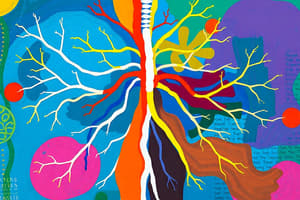Podcast
Questions and Answers
What is the overall function of the nervous system?
What is the overall function of the nervous system?
To receive stimuli from the environment, process information, and issue commands to muscles and glands.
Which of the following are major anatomical subdivisions of the nervous system?
Which of the following are major anatomical subdivisions of the nervous system?
- Central Nervous System (CNS) (correct)
- Endocrine System
- Autonomic Nervous System (ANS)
- Peripheral Nervous System (PNS) (correct)
The peripheral nervous system is functionally divided into sensory and motor divisions.
The peripheral nervous system is functionally divided into sensory and motor divisions.
True (A)
What does the sensory (afferent) division of the peripheral nervous system do?
What does the sensory (afferent) division of the peripheral nervous system do?
What are the two functional subdivisions of the motor (efferent) division?
What are the two functional subdivisions of the motor (efferent) division?
The ___ is the part of the nervous system that includes the brain and spinal cord.
The ___ is the part of the nervous system that includes the brain and spinal cord.
What are the three universal properties of neurons?
What are the three universal properties of neurons?
What is the function of sensory (afferent) neurons?
What is the function of sensory (afferent) neurons?
Flashcards
Nervous System Communication
Nervous System Communication
The nervous system and endocrine system both work to coordinate bodily functions, but the nervous system uses neurons to send messages electrically and chemically.
Central Nervous System
Central Nervous System
The brain and spinal cord form the central nervous system, acting as the control center for the body.
Peripheral Nervous System
Peripheral Nervous System
Nerves, bundles of neuron axons, and ganglia, clusters of neuron cell bodies, make up the peripheral nervous system, connecting the CNS to the rest of the body.
Sensory and Motor Divisions
Sensory and Motor Divisions
Signup and view all the flashcards
Somatic vs. Visceral Sensory
Somatic vs. Visceral Sensory
Signup and view all the flashcards
Somatic vs. Autonomic Motor
Somatic vs. Autonomic Motor
Signup and view all the flashcards
Neuron Properties
Neuron Properties
Signup and view all the flashcards
Types of Neurons
Types of Neurons
Signup and view all the flashcards
Study Notes
Overview of the Nervous System
- Both the nervous system and the endocrine system are responsible for the body's internal coordination.
- The endocrine system uses hormones to communicate throughout the body.
- The nervous system uses neurons to send messages from cell to cell, via electrical and chemical methods.
- The nervous system receives stimuli from the external environment and transmits messages to the CNS.
- The CNS processes information and determines a response.
- The CNS issues commands to muscles and gland cells to execute the response.
Central and Peripheral Nervous Systems
- The CNS includes the brain and spinal cord.
- The PNS includes nerves and ganglia.
- A nerve is a bundle of neuron axons wrapped in connective tissue.
- Ganglia are clusters of neuron cell bodies concentrated in the PNS.
Functional Divisions of the Peripheral Nervous System
- The PNS is functionally divided into sensory and motor systems, each with further somatic and visceral categories.
- The sensory (afferent) division carries signals from receptors to the CNS.
- The somatic sensory division carries signals from receptors in the skin, muscles, bones, and joints.
- The visceral sensory division carries signals from the viscera (heart, lungs, stomach, and urinary bladder).
- The motor (efferent) division carries signals from the CNS to effectors.
- The somatic motor division carries signals to skeletal muscles and causes voluntary muscle contraction and reflexes.
- The visceral motor division (autonomic nervous system or ANS) carries signals to glands, cardiac, and smooth muscle. It is involuntary.
- The sympathetic division of the ANS stimulates and prepares the body for action.
- The parasympathetic division of the ANS has a calming effect on the body.
- The enteric nervous system is a network of nerves located within the digestive tract wall that assists with digestive function.
Properties of Neurons
- Neurons are made excitable by their ability to respond to stimuli.
- Neurons have the ability to conduct electricity, sending signals along their length.
- Neurons can secrete neurotransmitters at their tips.
- There are three types of neurons:
- Sensory neurons detect stimuli and send messages to the CNS.
- Interneurons receive signals from other neurons and send signals to other neurons.
- Motor neurons receive signals from the CNS and send signals to an effector organ.
Studying That Suits You
Use AI to generate personalized quizzes and flashcards to suit your learning preferences.




